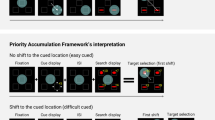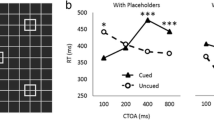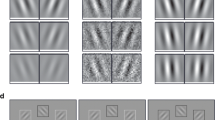Abstract
Can spatial attention be deployed as an annulus? Some studies have answered this question in the positive, others in the negative. We tested the hypothesis that annular deployment depends on the presence of a suitable structural framework to which attention can be anchored. To this end, we added a structural framework to the displays of a study that failed to find an annular distribution of attention. The targets were displayed in an annular region around a central stream of task-irrelevant distractors which captured attention and impaired target identification. This design was replicated in our No-Anchors condition. In the Anchors condition in Experiments 1 and 2, a square outline was displayed at each of the four possible target locations. Consistent with the idea that attention can be deployed as an annulus only when a visual framework is present, the targets were identified more accurately (Experiment 1) and more rapidly (Experiment 2) when anchors were present than when they were absent. The number of anchors was increased to eight in Experiment 3. In Experiment 4 the central stream was omitted to verify that the enhanced performance did not arise from intrinsic properties of the anchors themselves. In Experiment 5, targets were presented in a blank annular region delimited by two concentric circles, thus obviating the possibility that attention was deployed as four or eight separate foci in Experiments 2 and 3, respectively.






Similar content being viewed by others
Notes
We thank Jeremy Wolfe for pointing out the importance of discussing this alternative.
References
Bay, M., & Wyble, B. (2014). The benefit of attention is not diminished when distributed over two simultaneous cues. Attention, Perception, & Psychophysics, 1-11.
Beck, D. M., & Lavie, N. (2005). Look here but ignore what you see: Effects of distractors at fixation. Journal of Experimental Psychology: Human Perception and Performance, 31, 592–607.
Castiello, U., & Umiltà, C. (1990). Size of the attentional focus and efficiency of processing. Acta Psychologica, 73, 195–209.
Downing, C. J., & Pinker, S. (1985). The spatial structure of visual attention. In M. I. Posner & O. S. M. Marin (Eds.), Attention and performance Xl: Mechanisms of attention (pp. 171–187). Hillsdale, NJ: Erlbaum.
Egly, R., & Homa, D. (1984). Sensitization of the visual field. Journal of Experimental Psychology: Human Perception and Performance, 10, 778–793.
Eimer, M. (1999). Attending to quadrants and ring‐shaped regions: ERP effects of visual attention in different spatial selection tasks. Psychophysiology, 36, 491–503.
Eimer, M. (2000). An ERP study of sustained spatial attention to stimulus eccentricity. Biological Psychology, 52, 205–220.
Enns, J. T., Visser, T. A. W., Kawahara, J., & Di Lollo, V. (2001). Visual masking and task switching in the attentional blink. In K. L. Shapiro (Ed.), The Limits of Attention: Temporal Constraints on Human Information Processing (pp. 65-81). Oxford University Press.
Eriksen, C. W., & St. James, J. D. (1986). Visual attention within and around the field of focal attention: A zoom lens model. Perception & Psychophysics, 42, 225–240.
Eriksen, C. W., & Yeh, Y.-y. (1985). Allocation of attention in the visual field. Journal of Experimental Psychology: Human Perception and Performance, 11, 583–597.
Hughes, H. C., & Zimba, L. D. (1985). Spatial maps of directed visual attention. Journal of Experimental Psychology: Human Perception and Performance, 11, 409–430.
Jans, B., Peters, J. C., & De Weerd, P. (2010). Visual spatial attention to multiple locations at once: The jury is still out. Psychological Review, 117, 637–682.
Jefferies, L. N., Enns, J. T., & Di Lollo, V. (2014a). The flexible focus: Whether spatial attention is unitary or divided depends on observer goals. Journal of Experimental Psychology: Human Perception and Performance, 40, 465–470.
Jefferies, L. N., Gmeindl, L., & Yantis, S. (2014b). Attending to illusory differences in object size. Attention, Perception, & Psychophysics, 1–10.
Jolicœur, P., & Dell'Acqua, R. (1998). The demonstration of short-term consolidation. Cognitive Psychology, 36, 138–202.
Juola, J. F., Bouwhuis, D. G., Cooper, E. E., & Warner, C. B. (1991). Control of attention around the fovea. Journal of Experimental Psychology: Human Perception and Performance, 17, 125–141.
Kawahara, J. I., Enns, J. T., & Di Lollo, V. (2006). The attentional blink is not a unitary phenomenon. Psychological Research, 70, 405–413.
LaBerge, D. (1995). Attentional processing: The brain’s art of mindfulness. Cambridge, MA: Harvard University Press.
McMains, S. A., & Somers, D. C. (2004). Multiple spotlights of attentional selection in human visual cortex. Neuron, 42, 677–686.
Milner, A. D., & Goodale, M. A. (1995). The visual brain in action. Oxford: Oxford University Press.
Müller, M. M., & Hübner, R. (2002). Can the spotlight of attention be shaped like a doughnut? Evidence from steady-state visual evoked potentials. Psychological Science, 13, 119–124.
Müller, M. M., Malinowski, P., Gruber, T., & Hillyard, S. A. (2003). Sustained division of the attentional spotlight. Nature, 424, 309–312.
Posner, M. I. (1980). Orienting of attention. Quarterly Journal of Experimental Psychology, 32, 3–25.
Posner, M. I., & Cohen, Y. (1984). Components of visual orienting. Attention and Performance X: Control of Language Processes, 32, 531–556.
Potter, M. C., Chun, M. M., Banks, B. S., & Muckenhoupt, M. (1998). Two attentional deficits in serial target search: The visual attentional blink and an amodal task-switch deficit. Journal of Experimental Psychology: Learning, Memory, and Cognition, 24, 979–992.
Pylyshyn, Z. W., & Storm, R. W. (1988). Tracking multiple independent targets: Evidence for a parallel tracking mechanism. Spatial Vision, 3, 179–197.
Raymond, J. E., Shapiro, K. L., & Arnell, K. M. (1992). Temporary suppression of visual processing in an RSVP task: An attentional blink? Journal of Experimental Psychology: Human Perception and Performance, 18, 849–860.
Rizzolatti, G., Riggio, L., Dascola, I., & Umiltá, C. (1987). Reorienting attention across the horizontal and vertical meridians: Evidence in favor of a premotor theory of attention. Neuropsychologia, 25, 31–40.
Visser, T. A. W., Bischof, W. F., & Di Lollo, V. (1999). Attentional switching in spatial and non-spatial domains: Evidence from the attentional blink. Psychological Bulletin, 125, 458–469.
Visser, T. A. W., Bischof, W. F., & Di Lollo, V. (2004). Rapid serial visual distraction: Task-irrelevant items can produce an attentional blink. Perception & Psychophysics, 66, 1418–1432.
Weichselgartner, E., & Sperling, G. (1987). Dynamics of automatic and controlled visual attention. Science, 238, 778–780.
Zuvic, S. M., Visser, T. A., & Di Lollo, V. (2000). Direct estimates of processing delays in the attentional blink. Psychological Research, 63, 192–198.
Acknowledgments
This work was supported by a Sir Walter Murdoch Distinguished Collaborator Award to LNJ, by a Discovery Grant from the Natural Sciences and Engineering Research Council of Canada (NSERC) to VDL, and by a Discovery Accelerator Grant from NSERC to VDL. We thank Clare Kelly, Tamika Romanczuk, and Mahtut Yaynu for assistance with data collection at Murdoch University and Hayley Lagroix for organising the data collection at Simon Fraser University.
Author information
Authors and Affiliations
Corresponding author
Rights and permissions
About this article
Cite this article
Jefferies, L.N., Di Lollo, V. When can spatial attention be deployed in the form of an annulus?. Atten Percept Psychophys 77, 413–422 (2015). https://doi.org/10.3758/s13414-014-0790-4
Published:
Issue Date:
DOI: https://doi.org/10.3758/s13414-014-0790-4




